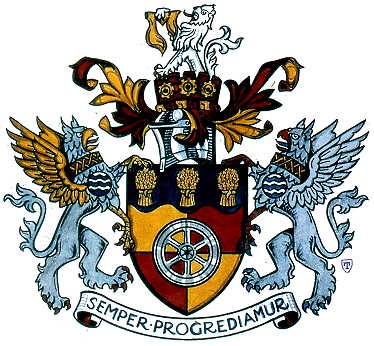Crewe and Nantwich
| Heraldry of the World |
| British heraldry portal Civic heraldry of the United Kingdom |
|
CREWE AND NANTWICH
Additions : 1974 Crewe Borough, Nantwich RDC, Nantwich UDC
Official blazon
Arms : Quarterly Or and Gules a Railway Wheel of six spokes proper on a Chief wavy Azure three Garbs Or.
Crest : On a Wreath of the Colours out of a Mural Crown Gules charged with three Cogwheels Or a demi Lion Argent grasping with the dexter claw a Maunch Or and resting the sinister claw on the Crown.
Supporters : On the dexter side a Griffin Sable beaked membered and winged Or on the sinister side a griffin Sable beaked and membered Gules winged Argent each gorged with a Collar Gules fretty Or and charged on the shoulder with a Fountain.
Motto : 'SEMPER PROGREDIAMUR' - Let us progress together.
Origin/meaning
The arms were officially granted on January 2, 1976.
The gold and red quarters are derived from the arms of the the de Malbanks, holders of the barony of Wich Malbank, one of the eight baronies of the Earldom of Chester. They held all the area now covered by the Nantwich authorities and Crewe, including Combermere Abbey, which owned Monks Coppenhall, the site of the modern Crewe.
Their arms were borne by Combermere Abbey and have been used by both former Nantwich Councils.
The railway wheel, here seen in its natural colours, was the main charge in the arms of the Borough of Crewe and symbolizes the importance and growth of Crewe in the railway system in modern times. Also from the Crewe arms is the blue wavy "chief" representing the River Waldron, on whose bank the railway junction was sited. Here it also represents also the River Weaver in the Nantwich area. In Crewe's shield were two of the famous gold Cheshire wheatsheaves, a third is added to represent the three Cheshire authorities united in the new District and the important agriculture of the rural area.
The mural crown is a symbol of local government, and here is also a reminder of the long-vanished castle at Nantwich. Like the mural crown in the County arms it is coloured red, a reminder of the local Cheshire sandstone. The three gold cogwheels represent the local engineering industries. The white lion, like that in the crest of Crewe, is from the arms of the Crewe family, associated with Nantwich and other parts of the new district, who attained marquisate rank but are now extinct. The gold "maunch" or mediaeval sleeve, from the Crewe shield, is a reference to the clothing industry.
The griffins are taken from the supporters of the Marquesses of Cholmondeley and the Barons of Crewe, who were associated with the manor of Nantwich and other parts of the new district. The lands of the barony of Wich Malbank eventually descended to the Marquesses of Cholmondeley, one of whose titles is Baron Cholmondeley of Namptwich. Each wears a distinctive collar, red with a fretted pattern of gold. These are taken from the arms of three of the district's and county's oldest families, all seated in the area: Audley, Foulshurst and Delves.
At the battle of Poitiers, Lord Audley, was awarded a prize by the Black Prince. He shared it with his four young squires, of whom
were John Delves and Robert Foulshurst, to whom he also gave a coat of arms based on his own. Their descendants continued in the area for many generations, and the Foulshursts held much of Nantwich and Crewe, the ermine from their arms being the field of the Borough arms. Thus the griffins' collars link the new district with one of the most famous of England's mediaeval battles and a well-known episode thereof.
For further distinction the griffins are charged on the shoulder with a "fountain" representing springs and natural waters. These recall the ancient salt industry of Nantwich, and in particular the single salt-pit known as The Old Biat.
Contact and Support
Partners:
Your logo here ?
Contact us
© since 1995, Heraldry of the World, Ralf Hartemink
Index of the site
Literature : Image and information provided by Laurence Jones


